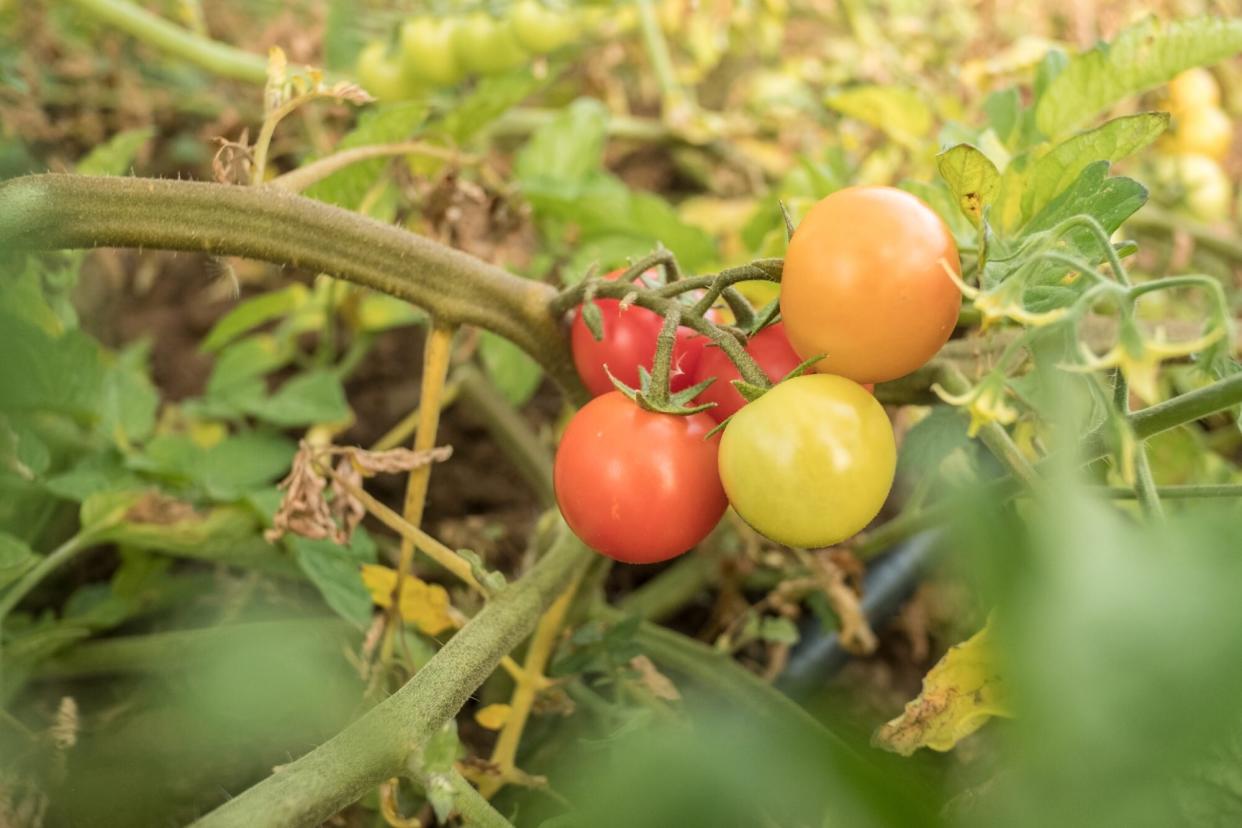3 Reasons Your Tomato Plant Leaves Are Turn ing Yellow

Getty Images
TABLE OF CONTENTS
On This Page
Nutrient Deficiency
Herbicide Damage
Disease
Tomato plants are a favorite crop among beginner and experienced gardeners alike, and both groups struggle with a common problem: their tomato leaves turning yellow. Tomatoes are prone to a variety of diseases and environmental factors that cause leaf discoloration. Fortunately, there are many ways to avoid these problems and to treat tomato plants displaying yellowing leaves. The first step is identifying the cause.
Yellow Leaves Can be a Sign of Nutrient Deficiency
Tomato plants require a lot of nutrients to produce those delicious fruits – especially nitrogen. A sign of nitrogen deficiency is the yellowing of older leaves as these leaves send nutrients to young growing foliage. Iron and magnesium deficiencies can also cause yellowing foliage. Inadequate iron causes young leaves to appear yellow with green veins, while magnesium deficiency causes blotches or spots on older leaves.
Solution
Feed plants regularly with a balanced, complete fertilizer that contains micronutrients. The best way to determine fertilizer needs is through a soil test which will tell you the composition, pH, and nutrient availability of your soil. Understanding soil pH is important, as it can limit the availability of certain nutrients.
In general, tomatoes benefit from incorporating 1.5 pounds of 10-10-10 fertilizer for 100 square feet into the upper 6 inches of soil prior to planting. Side-dress plants with an additional 1 pound per 100 square feet after the first tomatoes begin to form, and repeat every three to four weeks. If you experience excess foliar growth but few fruits, cut back on fertilizer or use a low-nitrogen mix. Be sure to water plants well after fertilizing. Tomatoes require a lot of water during the growing season–1 to 2 inches per week depending on soil type and growth stage.
Avoid Herbicide Damage
Tomatoes are sensitive to herbicide drift which can cause stunted growth, curling leaves, and leaf yellowing (chlorosis). An easy way to identify drift problems is to look at the broader garden. Herbicide drift will affect many different plants, not just your tomatoes.
Solution
It is best to avoid using herbicides near your tomatoes and rely on hand weeding instead. In other areas of the landscape, avoid applying herbicides on windy days. If you live near an agricultural field, talk with your neighbors about best practices to limit drift. Consider planting a more tolerant windbreak crop along the periphery of your garden.
Diseases Are a Common Culprit of Yellow Tomato Leaves
Tomatoes are plagued by several plant diseases, many of which cause yellowing of the foliage. One of the most common is early blight, a disease caused by the fungus Alternaria solani which typically starts at the bottom of the plant and moves up. While it takes a trained eye to identify specific plant diseases, control measures are similar for each.
Solution
While no single management strategy can completely prevent plant diseases, a combination of the following practices offers your best defense against tomato diseases.
Water Management
Bacterial and fungal diseases need a moist environment to develop. Limit foliage moisture by using drip irrigation or watering plants at the base using a hose. When using overhead sprinklers, water in the morning to allow the sun to dry foliage.
Plant Resistant Varieties
Many tomato varieties have been specifically bred or hybridized to select for disease and other pest resistance. Look for the following abbreviations in plant catalogs and on labels when selecting varieties.
V = Verticillium Wilt
F = Fusarium Wilt
FF = Fusarium Wilt race 1 and 2
T = Tobacco Mosaic Virus
A = Alternaria (Early Blight)
TSW = Tomato Spotted Wilt
N = Nematode
Staking
Staking tomato plants helps manage disease problems by increasing air circulation in the leaf canopy and reducing contact with the soil.
Crop Rotation
Many tomato diseases spend part of their lifecycle in the soil. For this reason, rotating or moving your tomato crop to different areas of the garden each year can reduce disease occurrence. Rotate tomatoes with unrelated crops, avoiding areas where eggplants, potatoes, or peppers grew.
Practice Sanitation
Take care to clean up diseased and dead foliage from beneath tomato plants and dispose of it in the garbage rather than the compost pile.
Pruning
Some gardeners like to remove the lowest branches to prevent soil-borne diseases from splashing up onto the foliage during a rain event. Pruning tomatoes also improves yields.
Remember that plant diseases can spread from one plant to another. Wash your hands and pruning equipment after working on an infected plant to prevent spreading problems through the garden.

